Mihir Kale
Shammie
XTREME-UP: A User-Centric Scarce-Data Benchmark for Under-Represented Languages
May 24, 2023



Abstract:Data scarcity is a crucial issue for the development of highly multilingual NLP systems. Yet for many under-represented languages (ULs) -- languages for which NLP re-search is particularly far behind in meeting user needs -- it is feasible to annotate small amounts of data. Motivated by this, we propose XTREME-UP, a benchmark defined by: its focus on the scarce-data scenario rather than zero-shot; its focus on user-centric tasks -- tasks with broad adoption by speakers of high-resource languages; and its focus on under-represented languages where this scarce-data scenario tends to be most realistic. XTREME-UP evaluates the capabilities of language models across 88 under-represented languages over 9 key user-centric technologies including ASR, OCR, MT, and information access tasks that are of general utility. We create new datasets for OCR, autocomplete, semantic parsing, and transliteration, and build on and refine existing datasets for other tasks. XTREME-UP provides methodology for evaluating many modeling scenarios including text-only, multi-modal (vision, audio, and text),supervised parameter tuning, and in-context learning. We evaluate commonly used models on the benchmark. We release all code and scripts to train and evaluate models
CLSE: Corpus of Linguistically Significant Entities
Nov 04, 2022Abstract:One of the biggest challenges of natural language generation (NLG) is the proper handling of named entities. Named entities are a common source of grammar mistakes such as wrong prepositions, wrong article handling, or incorrect entity inflection. Without factoring linguistic representation, such errors are often underrepresented when evaluating on a small set of arbitrarily picked argument values, or when translating a dataset from a linguistically simpler language, like English, to a linguistically complex language, like Russian. However, for some applications, broadly precise grammatical correctness is critical -- native speakers may find entity-related grammar errors silly, jarring, or even offensive. To enable the creation of more linguistically diverse NLG datasets, we release a Corpus of Linguistically Significant Entities (CLSE) annotated by linguist experts. The corpus includes 34 languages and covers 74 different semantic types to support various applications from airline ticketing to video games. To demonstrate one possible use of CLSE, we produce an augmented version of the Schema-Guided Dialog Dataset, SGD-CLSE. Using the CLSE's entities and a small number of human translations, we create a linguistically representative NLG evaluation benchmark in three languages: French (high-resource), Marathi (low-resource), and Russian (highly inflected language). We establish quality baselines for neural, template-based, and hybrid NLG systems and discuss the strengths and weaknesses of each approach.
Mining Duplicate Questions of Stack Overflow
Oct 04, 2022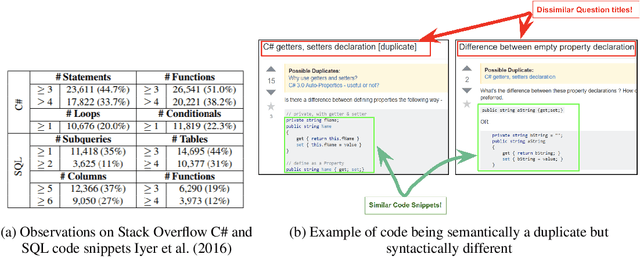
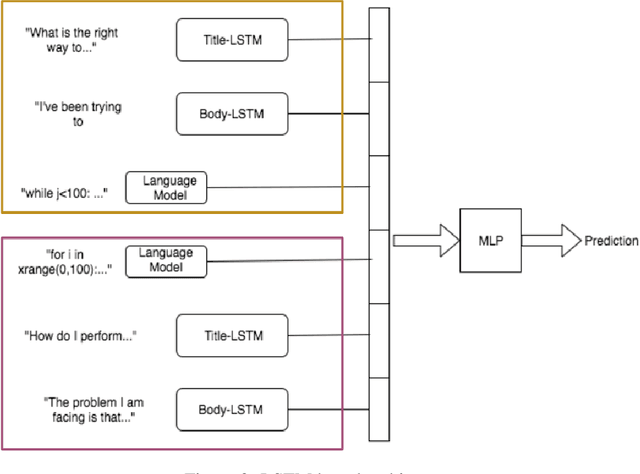
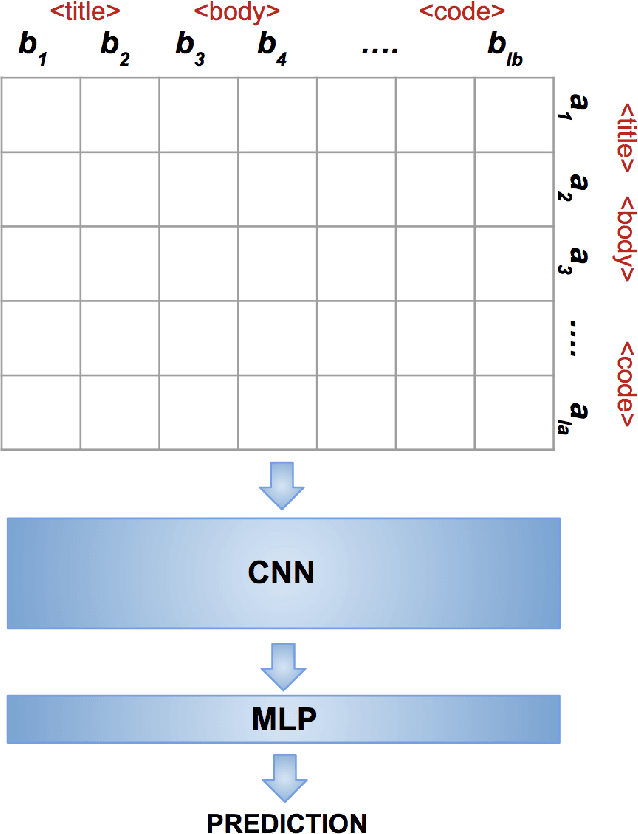
Abstract:There has a been a significant rise in the use of Community Question Answering sites (CQAs) over the last decade owing primarily to their ability to leverage the wisdom of the crowd. Duplicate questions have a crippling effect on the quality of these sites. Tackling duplicate questions is therefore an important step towards improving quality of CQAs. In this regard, we propose two neural network based architectures for duplicate question detection on Stack Overflow. We also propose explicitly modeling the code present in questions to achieve results that surpass the state of the art.
Beyond the Imitation Game: Quantifying and extrapolating the capabilities of language models
Jun 10, 2022Abstract:Language models demonstrate both quantitative improvement and new qualitative capabilities with increasing scale. Despite their potentially transformative impact, these new capabilities are as yet poorly characterized. In order to inform future research, prepare for disruptive new model capabilities, and ameliorate socially harmful effects, it is vital that we understand the present and near-future capabilities and limitations of language models. To address this challenge, we introduce the Beyond the Imitation Game benchmark (BIG-bench). BIG-bench currently consists of 204 tasks, contributed by 442 authors across 132 institutions. Task topics are diverse, drawing problems from linguistics, childhood development, math, common-sense reasoning, biology, physics, social bias, software development, and beyond. BIG-bench focuses on tasks that are believed to be beyond the capabilities of current language models. We evaluate the behavior of OpenAI's GPT models, Google-internal dense transformer architectures, and Switch-style sparse transformers on BIG-bench, across model sizes spanning millions to hundreds of billions of parameters. In addition, a team of human expert raters performed all tasks in order to provide a strong baseline. Findings include: model performance and calibration both improve with scale, but are poor in absolute terms (and when compared with rater performance); performance is remarkably similar across model classes, though with benefits from sparsity; tasks that improve gradually and predictably commonly involve a large knowledge or memorization component, whereas tasks that exhibit "breakthrough" behavior at a critical scale often involve multiple steps or components, or brittle metrics; social bias typically increases with scale in settings with ambiguous context, but this can be improved with prompting.
XTREME-S: Evaluating Cross-lingual Speech Representations
Apr 13, 2022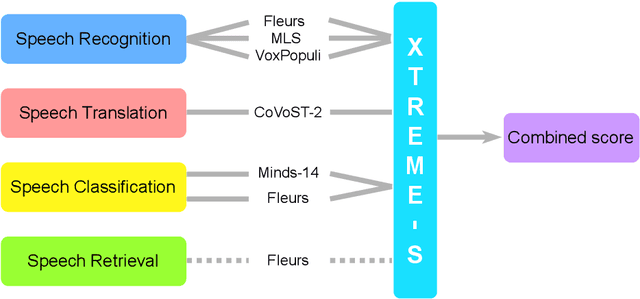


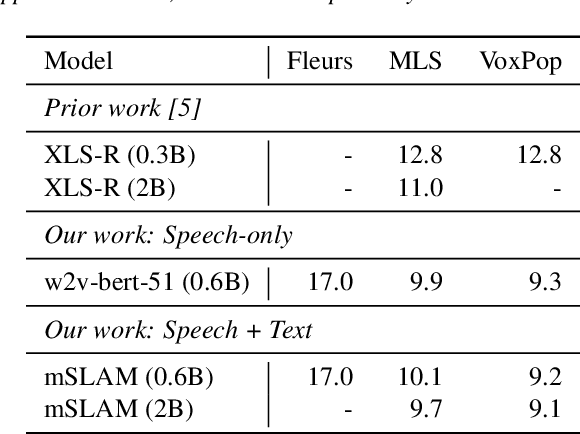
Abstract:We introduce XTREME-S, a new benchmark to evaluate universal cross-lingual speech representations in many languages. XTREME-S covers four task families: speech recognition, classification, speech-to-text translation and retrieval. Covering 102 languages from 10+ language families, 3 different domains and 4 task families, XTREME-S aims to simplify multilingual speech representation evaluation, as well as catalyze research in "universal" speech representation learning. This paper describes the new benchmark and establishes the first speech-only and speech-text baselines using XLS-R and mSLAM on all downstream tasks. We motivate the design choices and detail how to use the benchmark. Datasets and fine-tuning scripts are made easily accessible at https://hf.co/datasets/google/xtreme_s.
Improving Compositional Generalization with Self-Training for Data-to-Text Generation
Oct 16, 2021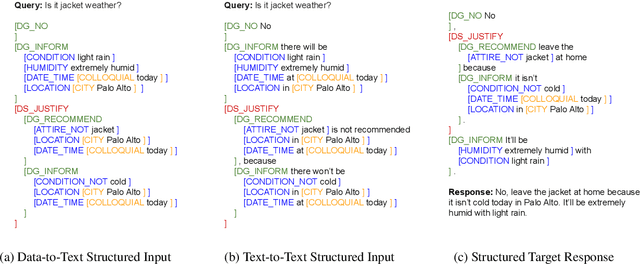



Abstract:Data-to-text generation focuses on generating fluent natural language responses from structured semantic representations. Such representations are compositional, allowing for the combination of atomic meaning schemata in various ways to express the rich semantics in natural language. Recently, pretrained language models (LMs) have achieved impressive results on data-to-text tasks, though it remains unclear the extent to which these LMs generalize to new semantic representations. In this work, we systematically study the compositional generalization of current state-of-the-art generation models in data-to-text tasks. By simulating structural shifts in the compositional Weather dataset, we show that T5 models fail to generalize to unseen structures. Next, we show that template-based input representations greatly improve the model performance and model scale does not trivially solve the lack of generalization. To further improve the model's performance, we propose an approach based on self-training using finetuned BLEURT for pseudo-response selection. Extensive experiments on the few-shot Weather and multi-domain SGD datasets demonstrate strong gains of our method.
Using Machine Translation to Localize Task Oriented NLG Output
Jul 09, 2021

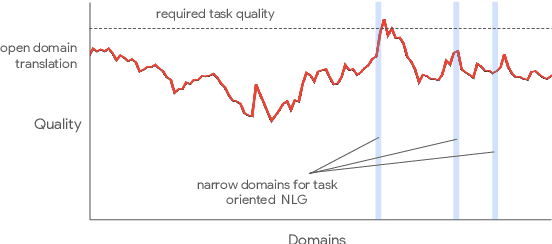
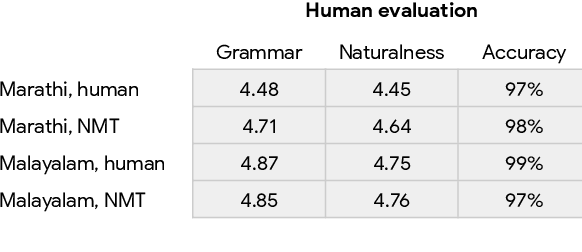
Abstract:One of the challenges in a task oriented natural language application like the Google Assistant, Siri, or Alexa is to localize the output to many languages. This paper explores doing this by applying machine translation to the English output. Using machine translation is very scalable, as it can work with any English output and can handle dynamic text, but otherwise the problem is a poor fit. The required quality bar is close to perfection, the range of sentences is extremely narrow, and the sentences are often very different than the ones in the machine translation training data. This combination of requirements is novel in the field of domain adaptation for machine translation. We are able to reach the required quality bar by building on existing ideas and adding new ones: finetuning on in-domain translations, adding sentences from the Web, adding semantic annotations, and using automatic error detection. The paper shares our approach and results, together with a distillation model to serve the translation models at scale.
Automatic Construction of Evaluation Suites for Natural Language Generation Datasets
Jun 16, 2021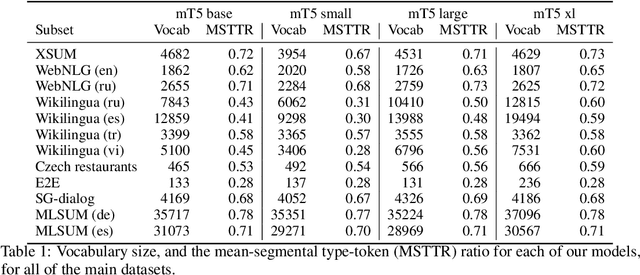
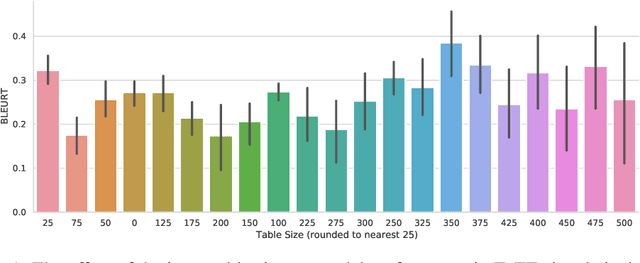
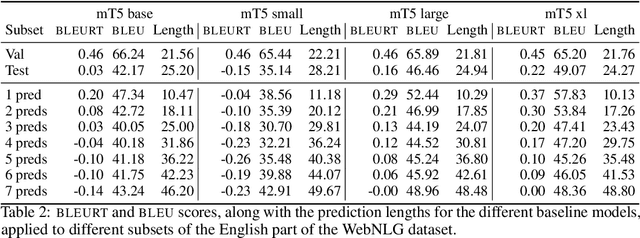
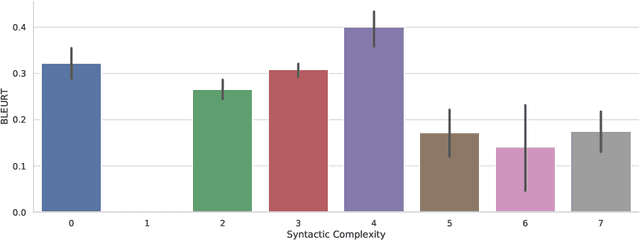
Abstract:Machine learning approaches applied to NLP are often evaluated by summarizing their performance in a single number, for example accuracy. Since most test sets are constructed as an i.i.d. sample from the overall data, this approach overly simplifies the complexity of language and encourages overfitting to the head of the data distribution. As such, rare language phenomena or text about underrepresented groups are not equally included in the evaluation. To encourage more in-depth model analyses, researchers have proposed the use of multiple test sets, also called challenge sets, that assess specific capabilities of a model. In this paper, we develop a framework based on this idea which is able to generate controlled perturbations and identify subsets in text-to-scalar, text-to-text, or data-to-text settings. By applying this framework to the GEM generation benchmark, we propose an evaluation suite made of 80 challenge sets, demonstrate the kinds of analyses that it enables and shed light onto the limits of current generation models.
nmT5 -- Is parallel data still relevant for pre-training massively multilingual language models?
Jun 03, 2021



Abstract:Recently, mT5 - a massively multilingual version of T5 - leveraged a unified text-to-text format to attain state-of-the-art results on a wide variety of multilingual NLP tasks. In this paper, we investigate the impact of incorporating parallel data into mT5 pre-training. We find that multi-tasking language modeling with objectives such as machine translation during pre-training is a straightforward way to improve performance on downstream multilingual and cross-lingual tasks. However, the gains start to diminish as the model capacity increases, suggesting that parallel data might not be as essential for larger models. At the same time, even at larger model sizes, we find that pre-training with parallel data still provides benefits in the limited labelled data regime.
ByT5: Towards a token-free future with pre-trained byte-to-byte models
May 28, 2021



Abstract:Most widely-used pre-trained language models operate on sequences of tokens corresponding to word or subword units. Encoding text as a sequence of tokens requires a tokenizer, which is typically created as an independent artifact from the model. Token-free models that instead operate directly on raw text (bytes or characters) have many benefits: they can process text in any language out of the box, they are more robust to noise, and they minimize technical debt by removing complex and error-prone text preprocessing pipelines. Since byte or character sequences are longer than token sequences, past work on token-free models has often introduced new model architectures designed to amortize the cost of operating directly on raw text. In this paper, we show that a standard Transformer architecture can be used with minimal modifications to process byte sequences. We carefully characterize the trade-offs in terms of parameter count, training FLOPs, and inference speed, and show that byte-level models are competitive with their token-level counterparts. We also demonstrate that byte-level models are significantly more robust to noise and perform better on tasks that are sensitive to spelling and pronunciation. As part of our contribution, we release a new set of pre-trained byte-level Transformer models based on the T5 architecture, as well as all code and data used in our experiments.
 Add to Chrome
Add to Chrome Add to Firefox
Add to Firefox Add to Edge
Add to Edge